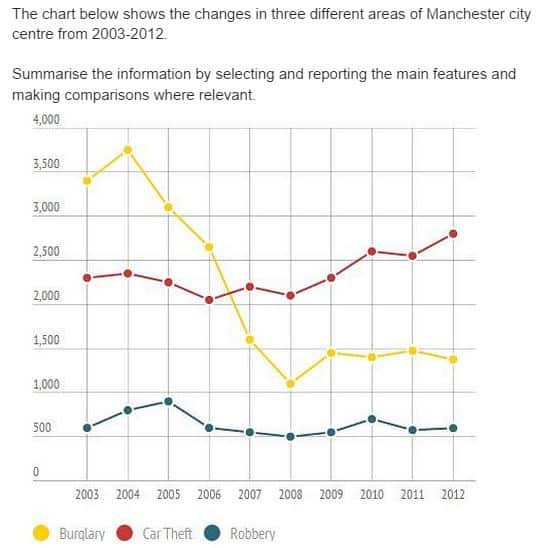5 Common IELTS Writing Task 1 Mistakes That Stop You From Getting Over a Band 6
1. Not Writing a Clear Overview
Your overview is the most important part of your whole response for IELTS Writing Task 1.
This should be a short paragraph that tells the reader 2 or 3 of the most significant things about the chart, graph, table etc. It should contain no data and instead describe the main features in general terms.
If you look at the IELTS Marking Criteria for Task 1, it states that candidates must ‘present a clear overview of main trends, differences or stages’ in order to get a Band 7. In other words, if you don’t write a clear overview, you can’t get a Band 7 or above.
Don’t know how to write a Task 1 overview? Read my guide to writing an effective overview here.
2. Trying to Write About Everything
Every Academic Task 1 question states ‘Summarise the information by selecting and reporting the main features…’. ‘Summarise’ means that you should only mention the main points, or as the question states, ‘the main features.’
Lots of students try to write about every piece of information they see. This normally leads to a very disorganised essay and often means that you run out of time, or even worse, run over time and fail to complete Task 2.
Always keep in mind that this task is as much about what you do not write as it is about what you do write. This is often a case of prioritisation. When teaching my VIP students how to write an overview, I suggest that they only tell the examiner 3 things and 3 things only about the graph. This prioritisation helps them to write a clear and effective overview.
3. Over-complicating the Question
The examiners know that you have never seen the graph or chart before and that you only have 20 minutes to write about it, so they are not expecting miracles. To help you, the graphs are much simpler than you think.
Look at the graph below and try to spot the three general trends. Try not to get caught up in the details, just focus on what is happening generally from the start date to the end.

In general, one goes up, one goes down and one stays relatively stable. It is often that simple! If you reported those three main trends you would be correct, but many students (especially the higher-level ones) think that this is too simple and try to find data that is not really there to find.
4. Not Organising Ideas Logically
The most logical way to organise a Task 1 report is:
Paragraph 1- Introduction
Paragraph 2- Overview of main features
Paragraph 3- Details of main features 1
Paragraph 4- Details of main features 2
See my lesson on Task 1 charts for more details about this structure above.
Remember: It’s important that you keep it simple and make sure your report is easy for the reader to understand. You could hand a Band 9 answer to a stranger and they would be able to read it once and roughly draw the graph or chart.
If you struggle to write a clear IELTS Writing Task 1 report, paragraphing and grouping ideas together logically help the reader to understand everything more easily.
5. Describing Data Incorrectly
Describing general trends and changes in data requires very specific grammar structures and vocabulary.
The most common mistake students make in IELTS Writing Task 1 is trying to use grammar or vocabulary they are not sure about. Remember: your grammar and vocabulary need to be accurate or you will lose marks.
You should also avoid describing data too precisely. For example, if you look at the figure for ‘Car Theft’ in 2003, it would be better to say ‘approximately/around 2300’ or ‘just under 2500’ than ‘2300’ because we don’t know what the figures are exactly from just looking at the graph.
